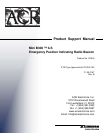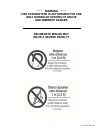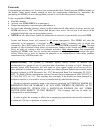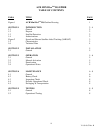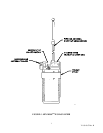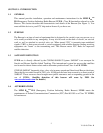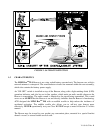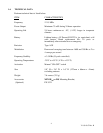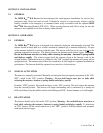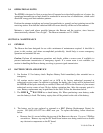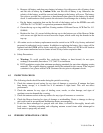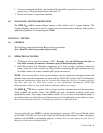7
Y1-03-0167 Rev. B
b. Remove old battery and place new battery in battery clip with groove side of battery down
and flat side of battery up. Caution: Make sure flat side of battery is up. Otherwise, the
polarity of the battery would be reversed and damage to the battery will occur. The battery
also poses a possible fire, explosion, or burn hazard when placed in the battery clip upside
down. A semiconductor diode protects the electronics from damage due to battery reversal.
c. Put the battery expiration date on the flat side of the battery and on the EPIRB case with
ACR Part No. A1-20-0857 or equivalent permanent shield label.
d. Grease the top cap o-ring with Dow Corning number 4 Silicone Grease, ACR Part No. A2-
09-0069.
e. Replace the four- (4) screws holding the top cap to the bottom case of the Beacon. Make
sure screws are tight but do not use excessive torque, which could strip the threads in the
top cap.
5. All routine service or battery replacement must be carried out at ACR or by factory authorized
personnel at authorized service centers. In addition to replacing the battery, the o-rings will be
replaced and the EPIRB will be hydro statically re-certified. Please call ACR for the location
of your nearest authorized service center at least 30 days before expiration date.
6. Safety Precautions:
a) Warning: To avoid possible fire, explosion, leakage or burn hazard, do not open,
recharge, disassemble, heat above 71°C (160°F) or incinerate.
b) DOT regulations require that minimum packaging standards be met when shipping certain
materials. The original shipping container should be retained for this reason. If the original
container is lost, please contact ACR Customer Service prior to shipment of unit.
4.3 INSPECTION CHECK
The following checks should be made during the periodic servicing:
1. Check the antenna tip and spring for any signs of damage or corrosion. If antenna has been
bent during storage, it is normal for it to maintain a slight bend. This will not affect
performance.
2. Check the antenna for any signs of chafing, wear, cracks, or other damage, and signs of
resultant corrosion beneath the covering.
3. Check the antenna socket at the cap surface for any sign of looseness or corrosion.
4. Check the Beacon housing for signs of damage or mishandling. Dents or damage to the top
end could result in an operational malfunction during an emergency.
5. If unit has been submerged or sprayed with salt water, it should be thoroughly rinsed with
fresh water. Including extending and collapsing antenna several times while submerged in
fresh water to purge any salt water.
4.4 PERIODIC OPERATIONAL CHECK



